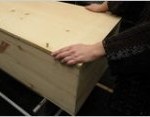 Paul Vittelo reports in the New York Times: The volunteers are taught to begin at the head, washing the face before proceeding to the neck and right shoulder. The right side is to be washed before the left side, the front before the back. There are prayers to say. Small talk is forbidden.
Paul Vittelo reports in the New York Times: The volunteers are taught to begin at the head, washing the face before proceeding to the neck and right shoulder. The right side is to be washed before the left side, the front before the back. There are prayers to say. Small talk is forbidden.
The Jewish protocol for tending to the dead governs almost every interaction between the living and the deceased from the moment of death until burial. The ritual, which has been part of religious law for two millenniums, mandates the protection of the physical and spiritual remains.
But for many decades, most Jews in the United States have lost touch with those protocols – if they have ever heard of them – in favor of conventional funeral home services that replace volunteers with professionals who, by their nature, skip the more metaphysical and personal elements of the process.
Now, a movement to restore lost tradition has motivated a new generation of Jewish volunteers to learn a set of skills that was common knowledge for many of their great-grandparents: the rituals of bathing, dressing and watching over the bodies of neighbors and friends who have died.
It is a nationwide revival propelled in almost equal parts, experts say, by an emerging sense of mortality among baby boomers, a reaction against the corporate character of the funeral home industry and a growing cultural receptivity to past spiritual practices, even some that make many people squeamish.
Rabbi Elchonon Zohn, the founder and director of Vaad Harabonim of Queens, a national association of rabbis who promote traditional burial, has crisscrossed the country in recent years teaching the philosophy and technique. He described the approach as attending not just to the bodies, but also to “the feelings of the dead.”
“We don’t think of this being we are preparing for burial as a ‘body,’ ” said Rabbi Zohn, an Orthodox Jew whose knowledge of burial tradition is mainly sought after by the non-Orthodox. “It’s a person; and that person in our view is still alive in a parallel world, very much aware of what’s happening.”
People who can approach a deceased person in that spirit, he said, are potential members of a “chevra kadisha,” translated variously as a burial or sacred society.
In the New York region and on Long Island, where he has concentrated his efforts, Rabbi Zohn estimates that 25 percent of Jewish burials today incorporate the burial rituals, compared with about 2 or 3 percent 15 years ago.
His estimates are consistent with national trends, said David Zinner, executive director of Kavod v’Nichum, or Honor and Comfort, a Washington center for information on Jewish burial practice. “From approximately zero in the 1970s and ’80s, we now have literally hundreds of chevra kadishas operating in New York, New Jersey, Chicago, San Francisco, you name it,” Mr. Zinner said.
Two books, he added, are considered among the revival’s seminal influences: “The American Way of Death,” Jessica Mitford’s 1963 exposé about the funeral industry, and “A Plain Pine Box,” a 1981 work in which Rabbi Arnold M. Goodman describes a Minneapolis synagogue’s return to traditional burial practices.
For the most part, the volunteer tradition has been maintained in Orthodox communities, which make up about 20 percent of the American Jewish population, and lost among the others – Reform, Conservative or unaffiliated.
Members of the Park Slope Jewish Center, a Conservative congregation in Brooklyn that did not have a burial society within anyone’s memory, started a society about seven years ago, after the deaths of two congregation members in quick succession, both young mothers.
Gathering one evening recently in the basement of an Orthodox funeral home in Borough Park, Brooklyn, Rabbi Sandler-Phillips and some volunteers reviewed the ritual of preparing someone for burial.
The society has mobilized a dozen times in the past five years, but most members of the synagogue still use conventional funeral home services. The most recent burial in which the chevra kadisha participated took place in September.
“We will always address the person by name,” the rabbi said, standing with the others in a fluorescent-lighted room of white tile furnished with a stainless-steel table and a large, rectangular stone bath tank filled with water. “We begin with a prayer asking for forgiveness in advance if anything we do offends the honor of the deceased.”
The walls are covered in prayers to be said during the washing, lifting, emersion, drying and dressing of the body. Men prepare the bodies of men; women, those of women. No one outside the burial society may observe its work; and beyond the circle of those directly involved, volunteers may not discuss any individual’s rites.
Rabbi Sandler-Phillips said that during preparations, some people, herself included, prefer to sing rather than speak the prayers, which are mainly psalms and readings from the biblical Song of Solomon. Her favorite is the song that starts: “How beautiful you are, my beloved friend.”
At all times, she said, the emphasis is on the dignity of the deceased, and respect for the irreducible reality of death. Embalming is forbidden by Jewish law – one of the practical reasons for requiring burial within 24 hours – and so is the use of airtight coffins, or anything that impedes natural disintegration.
Ilene Rubenstein, 57, one of the volunteers, said most people in her congregation remained cautious about committing their remains to the care of neighbors and friends because of a kind of modesty, a sense that privacy is less disturbed if remains are handled by strangers and professionals, she said.
For some volunteers, there is also the fear of death.
“I have to admit, the first time, I wasn’t quite ready for what a dead body looks like,” Ms. Rubenstein said.
“But you get over that quickly,” she added, receiving nods of assent from the others. “And for myself, knowing that I will be in the hands of people who care about me,” she continued, glancing around her, “that’s what I want when it’s my turn.”
{NY Times/Matzav.com}












So happy to hear that more an more people are coming to Kever Yisroel the way they need to. Kol Hakovod to all those involved in helping out.